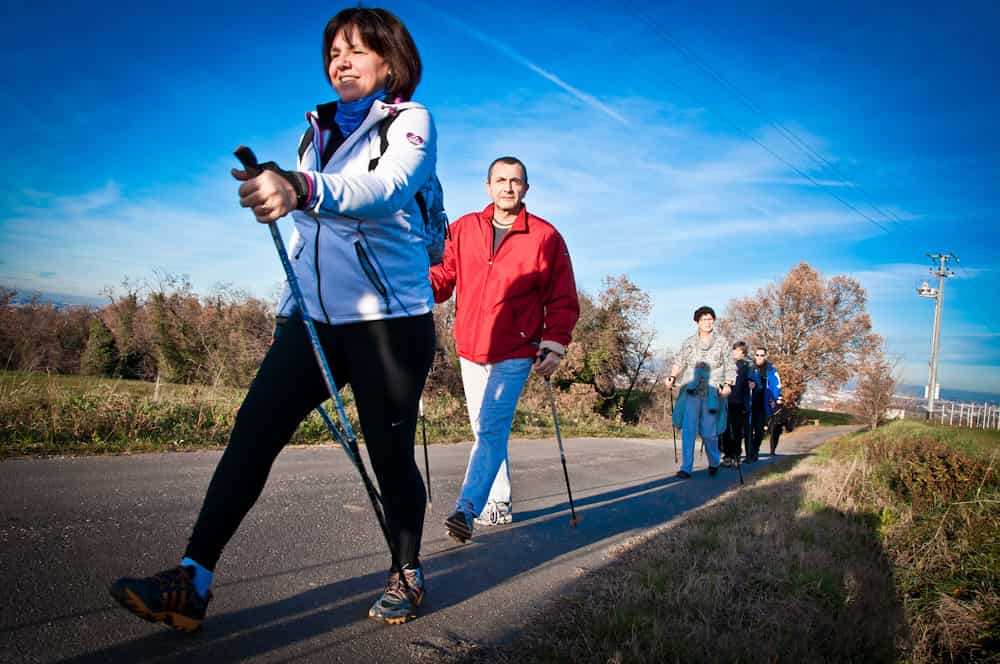Amongst various other factors contributing to longevity , the one that stands out is Walking .Walking, an often overlooked yet remarkably effective form of exercise, holds the key to unlocking a treasure trove of health benefits. From boosting physical fitness to enhancing mental well-being, walking is a simple yet powerful tool that can transform your life. This comprehensive guide delves into the world of walking, providing you with the knowledge and tools to incorporate this beneficial activity into your daily routine.

Benefits of Walking: A Journey to Holistic Wellness
Walking, despite its simplicity, is a multifaceted exercise that offers a multitude of benefits for people of all ages. Let’s explore the diverse ways in which walking can enhance your overall health and well-being:
Cardiovascular Health: I serves as a gentle yet effective cardiovascular workout, strengthening the heart muscle, improving blood circulation, and lowering blood pressure. This translates to a reduced risk of heart disease, stroke, and other cardiovascular ailments.
Weight Management: Walking plays a crucial role in weight management, aiding in burning calories and contributing to weight loss or maintenance. It also helps regulate metabolism, further supporting weight management goals.
Muscle Strength and Bone Health: Walking engages various muscle groups, enhancing their strength and endurance. It also helps maintain bone density, reducing the risk of osteoporosis and fractures.
Walking reduces the risk of breast cancer : According to American Cancer Society women who walked more than seven hours a week were 14 % less prone to the risk of breast cancer than women who walked lesser than three hours a week. This especially raises a red flag for women who are overweight or are undergoing hormone replacement therapy.
Immune System Enhancement: Regular walking has been shown to strengthen the immune system, making the body more resilient to infections and illnesses. During flu season, one research followed 1,000 people. Those who walked at a moderate speed for 30 to 45 minutes per day had 43 percent fewer ill days and upper respiratory tract infections overall. If they became ill, their symptoms were also reduced. This was in Stark contrast to people who had a sedentary lifestyle in the research.
Mental Well-being: Walking triggers the release of endorphins, natural mood-boosting chemicals, effectively reducing stress, anxiety, and depression. It fosters relaxation and removes mental fog making your mind clear.
Reduces joint discomfort :Walking can help protect your joints, particularly your knees and hips. It does this by lubricating and strengthening the muscles that support the joints. Walking may also bring benefits to persons suffering from arthritis, such as pain relief. In addition, walking 5 to 6 kilometres each week may help avoid arthritis.
Fosters your energy levels: Walking circulates oxygen throughout the body which makes eel rejuvenated. walking helps release cortisol, epinephrine, and norepinephrine in the body. Increased level of these hormones makes you feel more energetic. Walking is no less than a wonder.It is a far better option to go for a walk than settling down with a cup of hot coffee or tea or any other energy drink.
Live longer : Walking quicker might help you live longer. Researchers discovered that walking at an average rate, as opposed to a sluggish pace, resulted in a 20% lower risk of dying overall.
However, walking at a fast or brisk speed (at least 4 miles per hour) lowered the risk by 24%. The study looked at the relationship between walking faster and characteristics including total causes of death, cardiovascular disease, and cancer death.
Helps Control Sugar Cravings : Walking can help curb sugar cravings and control sweet tooth. A 15-minute walk can curb chocolate cravings and even reduce the amount of chocolate you eat in stressful situations, according to two studies from the University of Exeter.
Improve your mood : Walking can benefit your mental health. According to research, it can aid with anxiety, despair, and a bad mood. It can also improve self-esteem and alleviate feelings of social disengagement.
To reap these advantages, strive for 30 minutes of brisk walking or other moderate-intensity exercise three times each week. You may also divide it into three 10-minute walks.
Tailoring Walking Speed: Finding Your Optimal Pace
Walking speed is a critical factor in determining the intensity of your workout and the associated benefits. Here’s a breakdown of walking speeds and their corresponding effects:
Slow Walking (2-3 mph): Ideal for beginners or those with physical limitations. Still offers moderate health benefits.
Brisk Walking (3-4 mph): Considered a moderate-intensity workout, suitable for weight management and cardiovascular improvement.
Fast Walking (4-5 mph): A high-intensity workout, offering significant health benefits, including improved cardiovascular fitness, weight loss, and reduced risk of chronic diseases.
Age-Wise Walking Prescription: Exercise for Every Stage of Life
Walking is a versatile exercise that can be adapted to suit the needs and capabilities of individuals across all age groups. Here’s a guide to walking recommendations based on age:
Children (6-18 years): At least 60 minutes of moderate-to-vigorous physical activity daily, including walking.
Adults (19-64 years): At least 150 minutes of moderate-intensity aerobic activity or 75 minutes of vigorous-intensity aerobic activity weekly. Walking is an excellent choice for both.
Older Adults (65+ years): Aim for at least 150 minutes of moderate-intensity aerobic activity or 75 minutes of vigorous-intensity aerobic activity weekly. Walking is a safe and effective option.
Make walking a part of your daily regimen.
Make walking a habit by walking at the same time every day, for example.
Remember that you consume the same amount of energy regardless of when you walk, so do what is most convenient for you.
Asking someone to accompany you on your stroll may help you make it a habit. Some people find that maintaining an activity journal or record helps.
Possible Side Effects Of Walking
While walking is widely regarded as a safe and low-impact form of exercise, it’s important to be aware of a few potential side effects that may arise:
1. Muscle Soreness
Walking, particularly for those new to exercise or those who abruptly increase their walking intensity, can lead to muscle soreness. This soreness is typically mild and temporary, usually subsiding within a few days.
2. Shin Splints
Shin splints are a common overuse injury caused by repetitive impact on the lower legs. They are characterized by pain along the shins, particularly during or after walking. Proper footwear, regular stretching, and gradual increases in walking intensity can help prevent shin splints.
3. Joint Pain
Individuals with pre-existing joint conditions, such as arthritis, may experience joint pain during or after walking. If joint pain is severe or persistent, it’s crucial to consult a healthcare professional for guidance.
4. Blisters
Blisters can form on the feet due to friction between the skin and shoes. Wearing well-fitting, moisture-wicking socks can help prevent blisters from forming.
5. Dehydration
Walking can lead to dehydration, especially during hot weather or prolonged activity. It’s essential to drink plenty of water before, during, and after walking to maintain hydration levels.
To minimize the risk of side effects, it’s essential to start walking slowly, gradually increasing your intensity as your fitness level improves. Listen to what your body tells you and rest when your body tells you to. If you experience any persistent pain or discomfort, consult a healthcare professional for personalized advice.
Wear a pedometer when walking.
A pedometer keeps track of all the steps you take , the speed and various other parameters depending on how technologically advanced a pedometer you use. You can also use a pedometer app on your smart phone. You may track your activity throughout the day and compare it to previous days or suggested quantities. This may encourage you to move more. This is an excellent way to track your physical activity. The suggested amount of steps per day to gain health advantages is 10,000 or higher.
Wear The Right Shoes for walking
Walking is a low-cost, high-impact method of exercise. However, the improper shoe or walking style can cause foot or shin discomfort, blisters, and soft tissue damage.
Make sure your shoes are comfortable and have enough heel and arch support. Take small, gentle steps, making sure your heel comes down before your toes.
To assist absorb impact, walk on grass rather than concrete whenever feasible.
Celebrate Walking
Walking is a pleasurable form of physical activity that can be made more enjoyable by varying the location, walking with friends, or joining a walking club. To keep walking interesting, choose different routes, find friends or family members to walk with, and walk at different times of the day. Explore the sky, people, and sounds around you while walking.
Dog walking can also be a fun way to exercise and provide companionship. If you don’t have a dog, consider walking a neighbor’s dog occasionally. For safety, be considerate of other pedestrians and keep your dog on its leash. Check with your local council if parks or conservation reserves permit dog walking, and always bring equipment like plastic bags and gloves to clean up after your dog.
Walking will become more of a habit it is done with others and turned into a fun social activity . Schedule a regular family walk to pass on healthy habits to your children or grandchildren. Ensure the route and length of time spent walking are appropriate for their age and interests. For babies and toddlers, take the opportunity to point out highlights of interest, such as vehicles, flowers, and other pedestrians. Look for self-guided nature walks in parks, where younger children can learn about plants and animals, while older ones can take photos or record their experience.
Precautions and Safety Tips for Optimal Walking
To ensure a safe and enjoyable walking experience, follow these essential guidelines:
Warm-up and Cool-down: Before and after walking, incorporate gentle stretching and light physical activity to prepare your body and prevent injuries.
Choose the Right Footwear: Wear comfortable, supportive shoes that provide proper cushioning and arch support to protect your feet and joints.
Hydrate Regularly: Drink plenty of water before, during, and after walking to maintain hydration and prevent dehydration.
Stay Visible: Wear bright or reflective clothing, especially when walking in low-light conditions to ensure your visibility to others.
Listen to Your Body: Pay attention to any discomfort or pain and adjust your pace or rest accordingly. Do not over do it..
Seek Medical Advice: If you have any underlying health conditions, consult your doctor before starting a walking routine to ensure it’s safe for you.
Walking: A Simple Step Towards a Healthier and Happier You
Walking, in its simplicity, holds immense power to transform your life. By incorporating regular walking into your daily routine, you embark on a journey towards improved physical and mental well-being. Embrace the power of walking and experience the profound impact it can have on your overall health and happiness.
Reference : http://www.healthline.com







